Among the vibrant treasures of freshwater aquariums, the Bolivian Ram, alternatively known as Mikrogeophagus altispinosus, stands out for its stunning appearance and peaceful demeanor. This dwarf cichlid, belonging to the Cichlidae family, shares ties with other prominent species like the Blue Ram. The fish has a base coat of either silver or tan, complemented by beautiful reddish highlights. Its overall appearance exudes a graceful charm, which is further enhanced by the striking black vertical stripe and the iridescent scales, primarily found in males.
Table of Contents
Contrary to what some might think, the Bolivian Ram isn’t a rare gem in the fish-keeping realm. While its wild type remains the most sought-after variant, enthusiasts don’t find an extensive range of selectively bred color morphs as seen with other cichlids.
The natural abode of the Bolivian Ram traces back to the Amazon River basin, specifically in Brazil and Bolivia. Within aquarium confines, they exhibit a preference for the bottom and middle layers, relishing the comfort of well-planted spaces. Their dietary inclinations lean omnivorous, happily feasting on a mix of flakes, pellets, and live food. Their peaceful nature makes them a beloved choice for community tanks, though a touch of territoriality surfaces during breeding times.
In terms of statistics, these aquatic marvels can reach an impressive length of 3 to 3.5 inches and can thrive for up to 6 years when provided with optimal care. What makes the Bolivian Ram so endearing to aquarists, apart from its aesthetic appeal, is its resilience. Unlike its relative, the Blue Ram, the Bolivian variant proves hardier, welcoming novice fish keepers with open fins. Their fascinating courtship behaviors, wherein males flaunt their vivacity to charm females, serve as an aquatic spectacle. Dating back several decades in the aquarium hobby, their rise to fame can be credited to their dynamic colors and affable nature.
As we conclude our aquatic adventure, it is interesting to observe that the term “Ram” does not refer to the terrestrial mammal, but rather pays homage to a variety of dwarf cichlids. Whether you’re an established aquarist or just embarking on your fish-keeping adventure, the Bolivian Ram promises to be a delightful addition, merging beauty with simplicity.
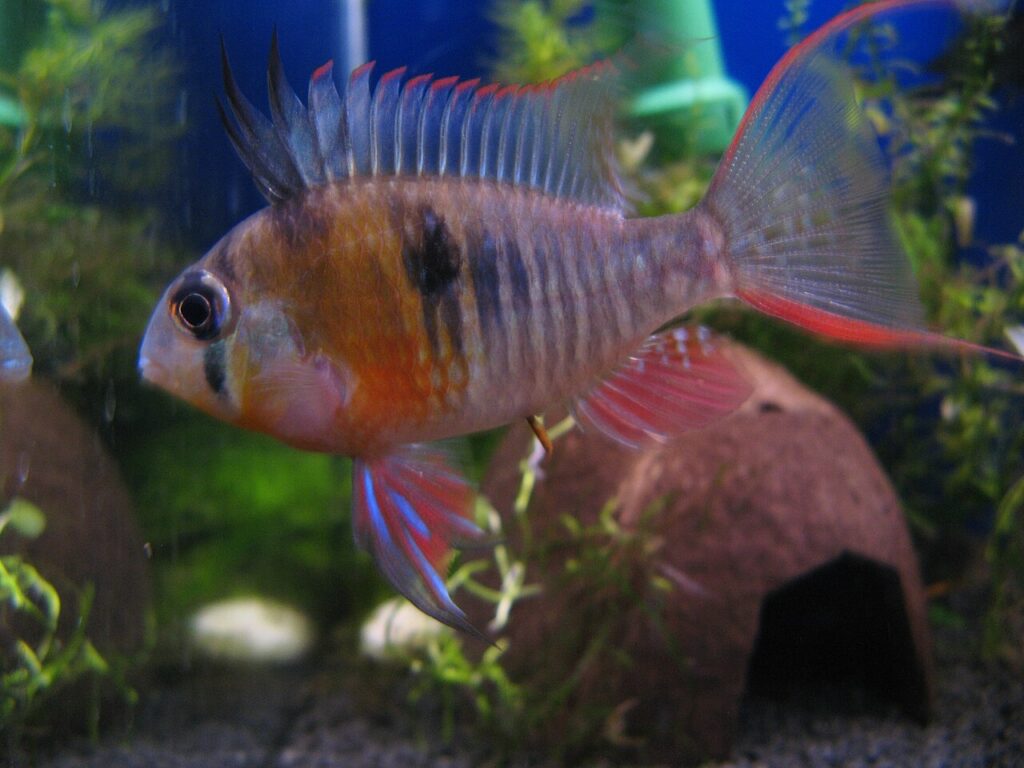
The Enchanting Bolivian Ram: A Comprehensive Overview
Diving into the world of freshwater fish, the Bolivian Ram captures the hearts of aquarists with its captivating colors and gentle temperament. A member of the Cichlidae family, this fish, with its unique characteristics and needs, stands as a testament to nature’s artistic touch. Here’s a comprehensive table to help you understand and care for the Bolivian Ram:
| Family | Cichlidae |
| Price | Varies depending on location, typically $6-$15 |
| Common Names | Bolivian Ram, Bolivian Butterfly, Ruby Crown Cichlid |
| Variants | Mainly the wild type |
| Ideal Tank Size | 30 gallons and above |
| Water Parameters | pH 6.5-7.5, Temperature 75-80°F (24-27°C) |
| Lifespan | 5-6 years |
| Full Size | 3-3.5 inches (8-9 cm) |
| Natural Environment | Amazon River basin in Brazil and Bolivia |
| Behavior | Peaceful but can be territorial during breeding |
| Habitat Preference | Bottom to mid-dwelling |
| Aquarium Decoration | Well-planted with hiding spots |
| Ideal Tank Mates | Tetras, Corydoras, Platies, Dwarf Gouramis |
| Fish to Avoid | Larger Cichlids, aggressive species |
| Best Foods/Diet | Flakes, pellets, brine shrimp, bloodworms |
| Disease | Vulnerable to Ich, fin rot; maintain clean water to prevent |
| Sex-Switch | Not common |
| Gender Differences | Males have brighter colors and are slightly larger |
| Care Level | Intermediate |
| Breeding Level | Moderate |
Armed with this knowledge, you’re well-equipped to offer the Bolivian Ram a comfortable and stimulating environment, ensuring a thriving and interactive aquarium experience.
Ideal Tank Mates for Bolivian Ram
When selecting tank mates for Bolivian Rams (Mikrogeophagus altispinosus), it’s essential to consider factors such as water parameters, temperament, and tank size. Bolivian Rams are peaceful, subtropical cichlids that thrive in well-planted aquariums with plenty of hiding spots and swimming space. They prefer slightly acidic to neutral water with a temperature range of 72-79°F (22-26°C).
Ideal tank mates for Bolivian Rams should have similar water requirements, peaceful temperaments, and be of appropriate size to prevent aggression or intimidation. It’s crucial to maintain a well-balanced community aquarium with proper filtration, regular water changes, and a varied diet to ensure the health and well-being of all inhabitants.
Here are 10 ideal tank mates for Bolivian Rams, along with their unique characteristics and compatibility reasons:
1. Neon Tetra (Paracheirodon innesi)
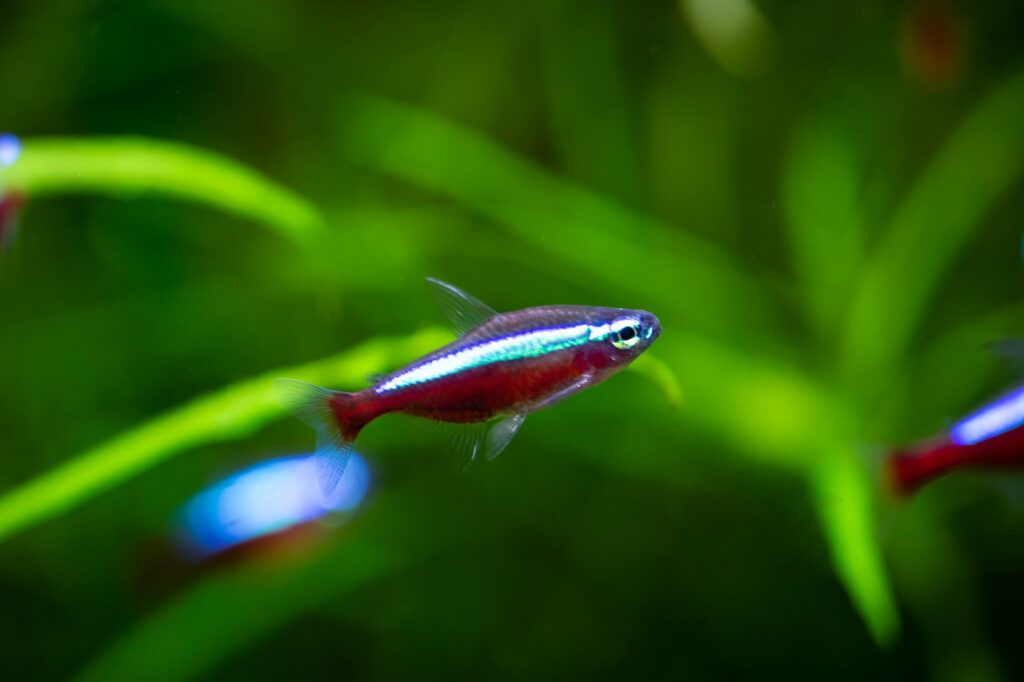
| Common/Market Names | Neon Fish, Neonfish |
| Price Range | $2 – $4 |
| Care Level | Easy |
| Behavior | Peaceful, Schooling |
| Life Span | 5 – 8 years |
| Max Size | 1.5 inches |
Neon Tetras are small, colorful, and peaceful schooling fish that make excellent tank mates for Bolivian Rams. Their vibrant blue and red coloration adds visual appeal to the aquarium without competing with the Rams’ colors. Neon Tetras prefer similar water conditions and do not interfere with the Rams’ territory, making them a compatible choice.
2. Rummy Nose Tetra (Hemigrammus rhodostomus)
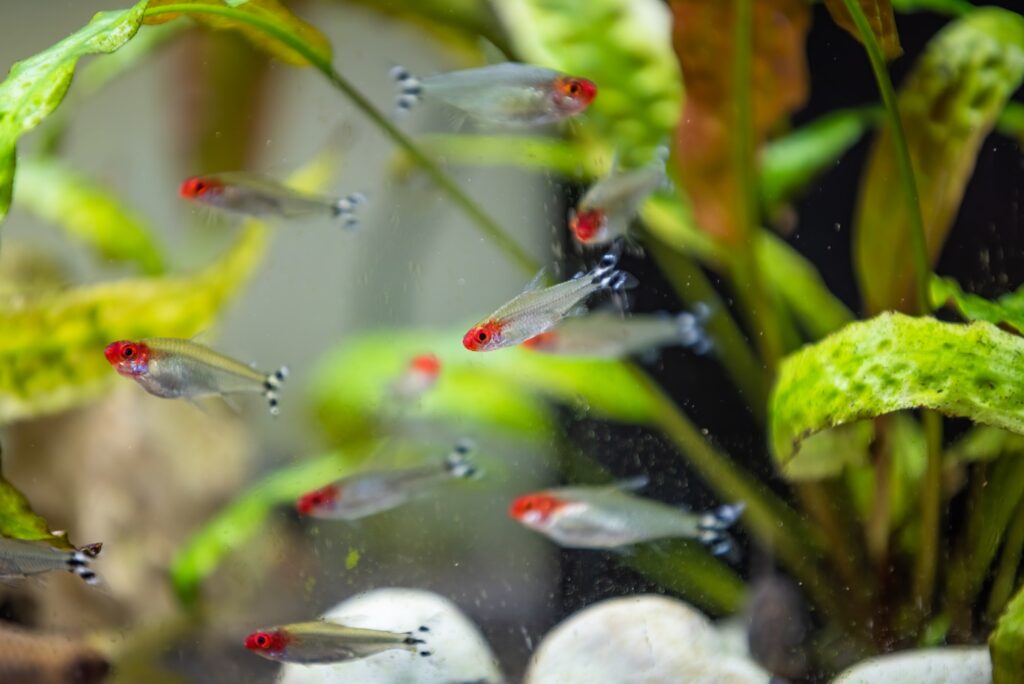
| Common/Market Names | Rummy Nose Fish, Firehead Tetra |
| Price Range | $3 – $6 |
| Care Level | Moderate |
| Behavior | Peaceful, Schooling |
| Life Span | 5 – 6 years |
| Max Size | 2.5 inches |
Rummy Nose Tetras are another peaceful schooling fish that coexist well with Bolivian Rams. Their distinct red heads and silvery bodies create an attractive contrast in the aquarium. Rummy Nose Tetras are more sensitive to water conditions than Neon Tetras, but they still share similar preferences with Bolivian Rams, making them a suitable tank mate.
3. Pygmy Corydoras (Corydoras pygmaeus)

| Common/Market Names | Pygmy Cory, Dwarf Corydoras |
| Price Range | $3 – $5 |
| Care Level | Easy |
| Behavior | Peaceful, Schooling, Bottom-dweller |
| Life Span | 3 – 5 years |
| Max Size | 1 inch |
Pygmy Corydoras are tiny, peaceful bottom-dwellers that help keep the aquarium clean by scavenging for leftover food and debris. Their small size and non-intrusive behavior make them an ideal addition to a Bolivian Ram tank. Pygmy Corydoras prefer similar water conditions and provide a unique dimension to the aquarium’s bottom level.
4. Otocinclus Catfish (Otocinclus spp.)
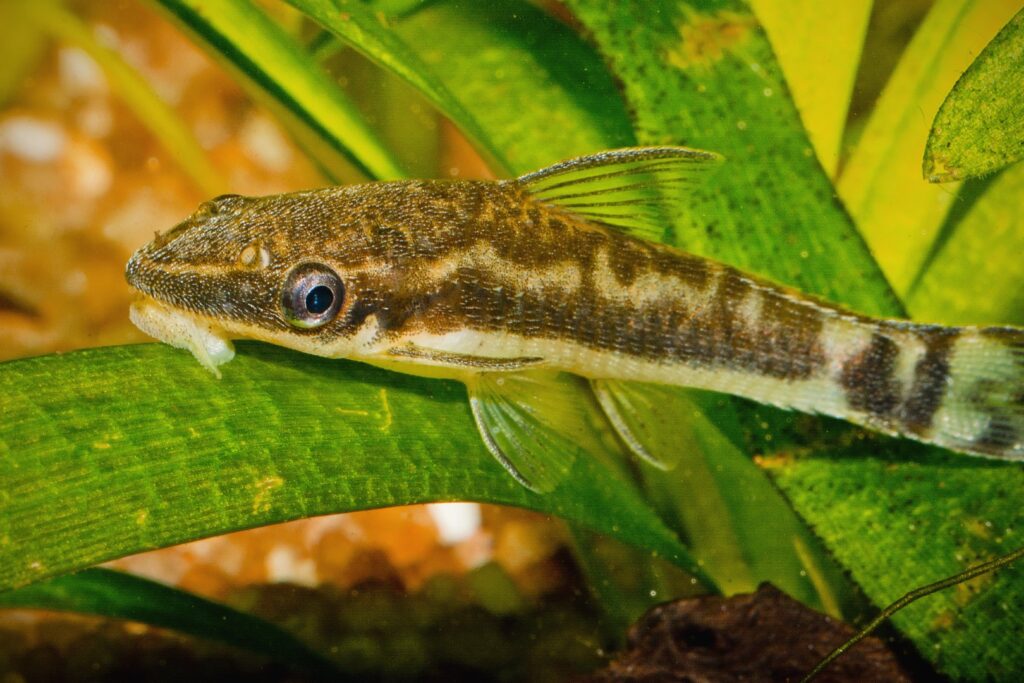
| Common/Market Names | Oto, Dwarf Suckermouth Catfish |
| Price Range | $3 – $5 |
| Care Level | Easy |
| Behavior | Peaceful, Algae-eater |
| Life Span | 3 – 5 years |
| Max Size | 2 inches |
Otocinclus Catfish are small algae-eating fish that help maintain a clean and healthy aquarium by consuming algae and biofilm. They are peaceful, non-territorial, and adaptable to the same water conditions as Bolivian Rams. Their unique appearance and beneficial role in the aquarium make them an excellent tank mate choice.
5. Dwarf Gourami (Trichogaster lalius)
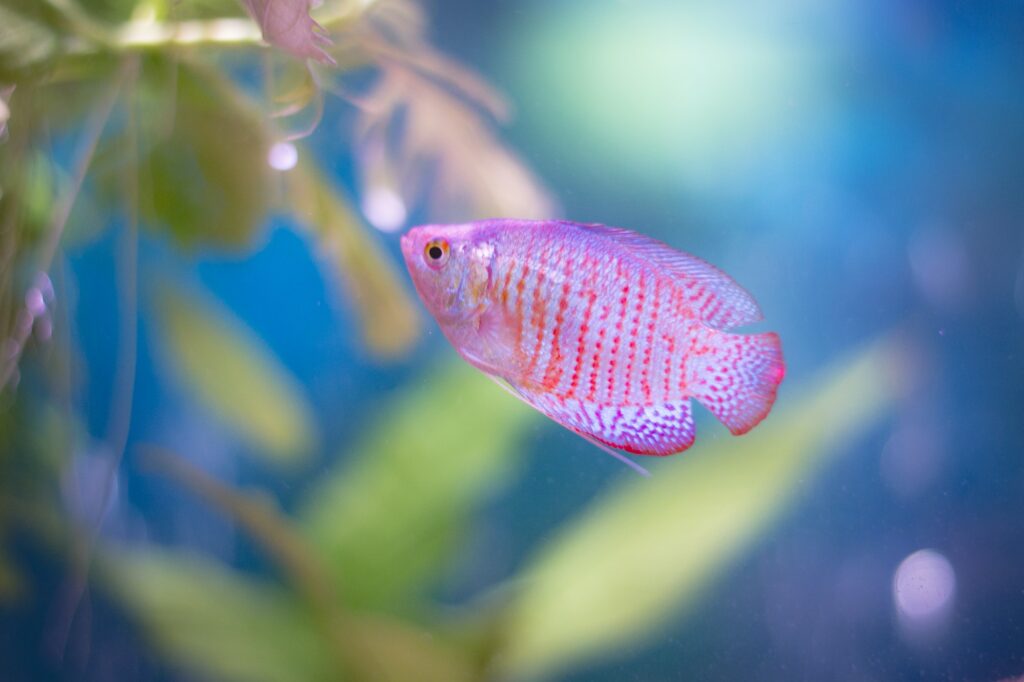
| Common/Market Names | Dwarf Gourami, Flame Gourami |
| Price Range | $4 – $8 |
| Care Level | Moderate |
| Behavior | Peaceful, Territorial |
| Life Span | 4 – 6 years |
| Max Size | 3.5 inches |
Dwarf Gouramis are colorful, peaceful labyrinth fish that add beauty and diversity to a Bolivian Ram tank. They occupy the upper levels of the aquarium, reducing competition for space with the Rams. However, male Dwarf Gouramis can be territorial with each other, so it’s best to keep only one male per tank or a pair. They share similar water preferences with Bolivian Rams.
6. Cherry Shrimp (Neocaridina davidi)
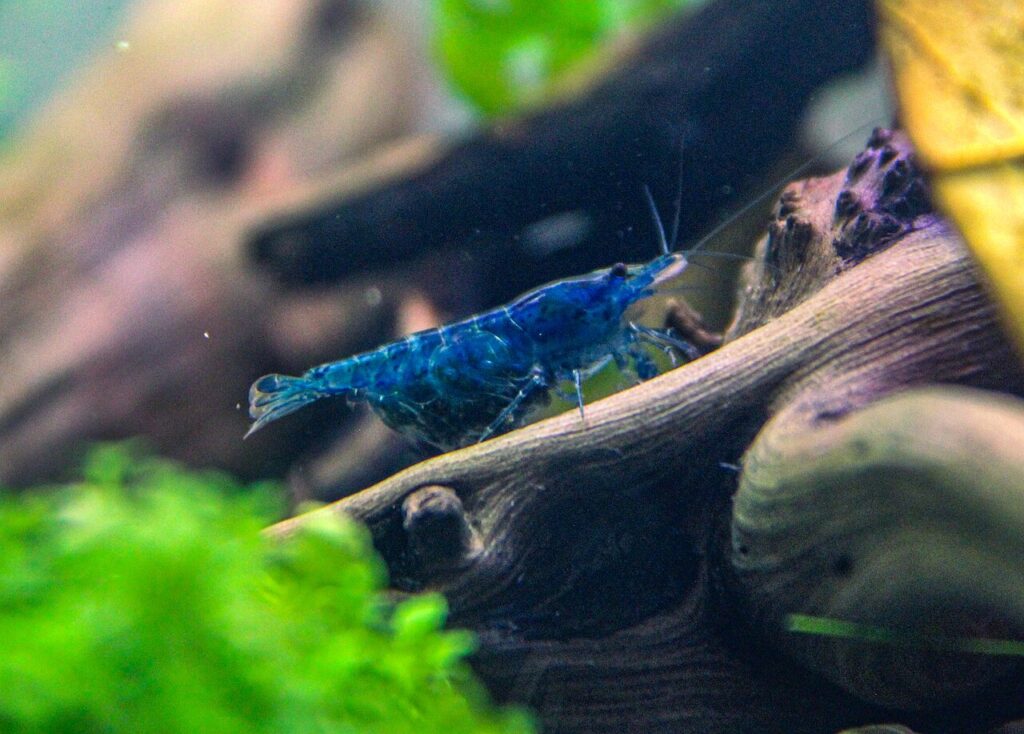
| Common/Market Names | Red Cherry Shrimp, RCS |
| Price Range | $2 – $4 |
| Care Level | Easy |
| Behavior | Peaceful, Scavenger |
| Life Span | 1 – 2 years |
| Max Size | 1.5 inches |
Cherry Shrimp are small, colorful invertebrates that make excellent tank mates for Bolivian Rams. They help keep the aquarium clean by consuming algae and decomposing plant matter. Cherry Shrimp are peaceful and adaptable to the same water conditions as Bolivian Rams. Their bright red color adds visual interest to the aquarium without posing a threat to the Rams.
7. Harlequin Rasbora (Trigonostigma heteromorpha)
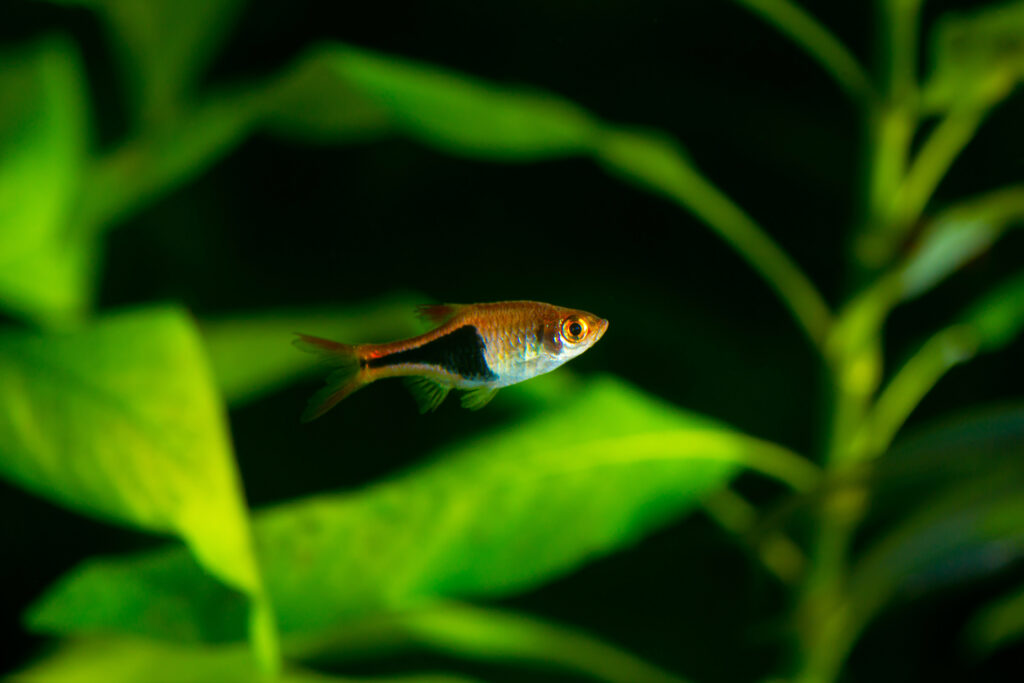
| Common/Market Names | Harlequin Fish, Red Rasbora |
| Price Range | $3 – $5 |
| Care Level | Easy |
| Behavior | Peaceful, Schooling |
| Life Span | 5 – 8 years |
| Max Size | 2 inches |
Harlequin Rasboras are peaceful, schooling fish with a unique triangular shape and attractive red and black coloration. They occupy the middle to upper levels of the aquarium, providing a visually appealing contrast to the Bolivian Rams. Harlequin Rasboras prefer similar water conditions and do not compete with the Rams for territory or resources.
8. Kuhli Loach (Pangio kuhlii)
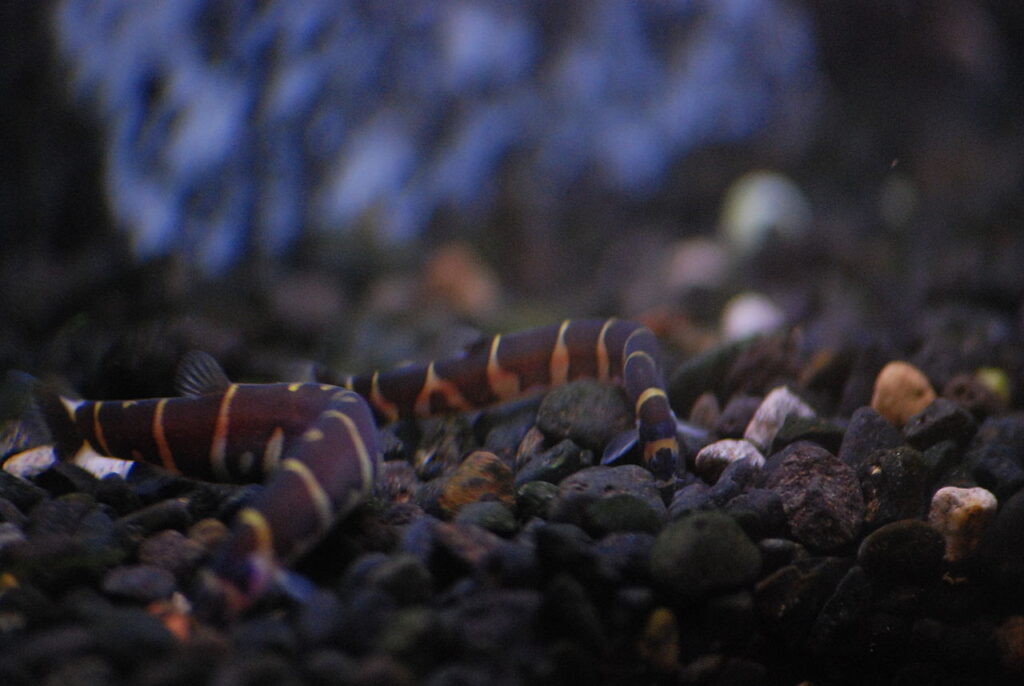
| Common/Market Names | Coolie Loach, Leopard Loach |
| Price Range | $3 – $5 |
| Care Level | Moderate |
| Behavior | Peaceful, Nocturnal, Bottom-dweller |
| Life Span | 10+ years |
| Max Size | 4 inches |
Kuhli Loaches are peaceful, eel-like bottom-dwellers that are most active during the night. Their unique appearance and behavior add diversity to a Bolivian Ram tank. Kuhli Loaches help keep the substrate clean by scavenging for leftover food and debris. They prefer similar water conditions to Bolivian Rams and do not interfere with their territory.
9. Bristlenose Pleco (Ancistrus spp.)
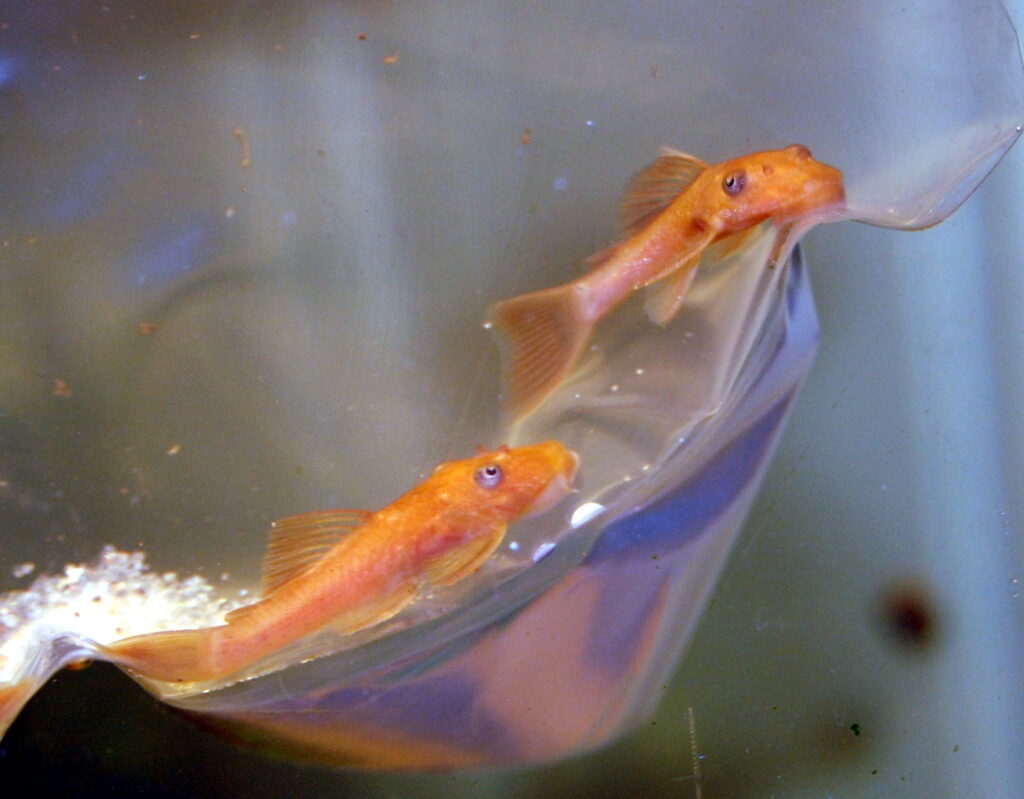
| Common/Market Names | Bushynose Pleco, Bristlenose Catfish |
| Price Range | $5 – $10 |
| Care Level | Easy |
| Behavior | Peaceful, Algae-eater |
| Life Span | 5 – 10 years |
| Max Size | 5 inches |
Bristlenose Plecos are peaceful, algae-eating catfish that help control algae growth in the aquarium. Their unique appearance, with bristle-like protrusions on their snouts, adds character to the tank. Bristlenose Plecos are nocturnal and occupy the lower levels of the aquarium, making them compatible with Bolivian Rams. They have similar water preferences and do not compete for resources.
10. Ember Tetra (Hyphessobrycon amandae)
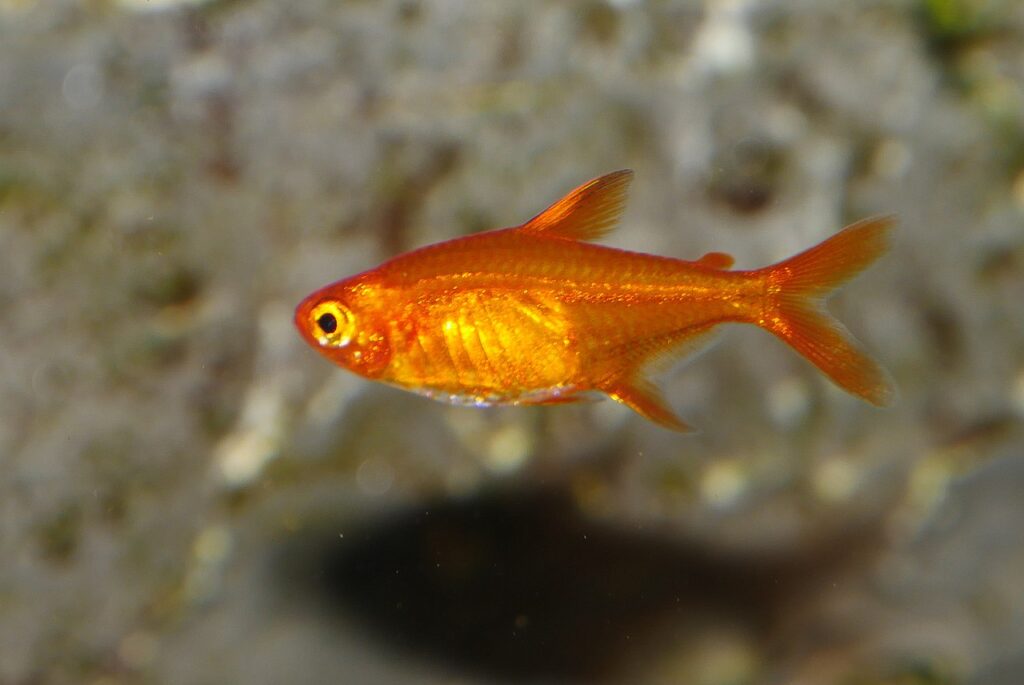
| Common/Market Names | Dwarf Amber Tetra, Amanda’s Tetra |
| Price Range | $2 – $4 |
| Care Level | Easy |
| Behavior | Peaceful, Schooling |
| Life Span | 2 – 4 years |
| Max Size | 0.8 inches |
Ember Tetras are small, peaceful schooling fish with a vibrant orange-red coloration that complements the colors of Bolivian Rams. Their tiny size and non-aggressive behavior make them an ideal addition to a peaceful community tank. Ember Tetras prefer similar water conditions to Bolivian Rams and occupy the middle to upper levels of the aquarium, reducing competition for space.
FAQs about Bolivian Ram
Are Bolivian Rams jumpers? Do I need a lid for my tank?
Like many fish, Bolivian Rams can jump, especially when stressed or scared. It’s advisable to have a lid on your tank to prevent any potential escape attempts.
Can I keep multiple Bolivian Rams together?
Yes, Bolivian Rams can be kept in pairs or small groups. However, ensure the tank is spacious enough to allow for territories, and monitor for any signs of excessive aggression, especially among males.
What signs indicate a healthy Bolivian Ram?
Active swimming, a good appetite, vibrant colors, clear eyes, and fins held open are indicators of a healthy Bolivian Ram. On the flip side, clamped fins, faded colors, or erratic swimming can be signs of stress or illness.
How can I differentiate between a stressed and a relaxed Bolivian Ram?
A relaxed Bolivian Ram will often display its vibrant colors, swim gracefully around the tank, and interact with tank mates without showing signs of aggression. A stressed fish, on the other hand, might exhibit faded colors, hide more often, have clamped fins, or breathe more rapidly.
Is it normal for Bolivian Rams to dig in the substrate?
Yes, it’s a natural behavior. Bolivian Rams often dig or sift through the substrate, either searching for food or establishing a breeding spot. It’s advisable to provide a soft sand substrate to prevent any injuries to the fish while it engages in this behavior.
What’s the ideal group size if I want a community of Bolivian Rams?
While they can be kept individually or in pairs, if you wish to have a community, a group of 4-6 Bolivian Rams in a sufficiently large tank is ideal. This provides them ample opportunity to establish territories and reduces the chances of aggression.
Can Bolivian Rams change color?
Yes, Bolivian Rams can change their color intensity based on their mood, environment, or health. A darkening color might indicate breeding behavior or stress, while vibrant colors usually indicate a healthy and content fish.
How do I set up a breeding tank for Bolivian Rams?
For breeding, provide a separate tank with softer water and a slightly higher temperature (around 82°F or 28°C). Including flat rocks or slate can serve as potential egg-laying sites. Ensure the tank has good water quality and a gentle water flow.
Are Bolivian Rams sensitive to medications?
Like many other fish, Bolivian Rams can be sensitive to certain medications, especially those containing copper. It’s crucial to always read the instructions and, if possible, consult with an expert or veterinarian before administering any treatment.